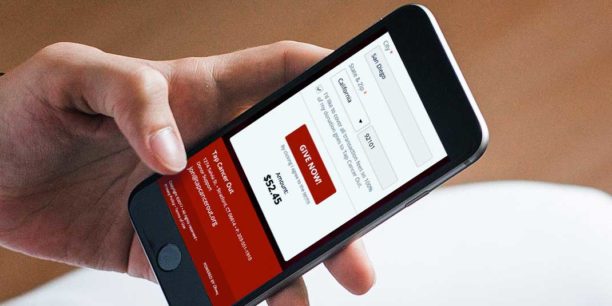10 Expert Tips for Google and Meta Advertising at Your Nonprofit

This blog was written in collaboration with The Smithee Group, a digital growth agency that specializes in enhancing messaging strategies, optimizing paid media, and streamlining nonprofit organizational planning.
In the modern digital age, nonprofits have countless opportunities to reach and engage with potential donors, volunteers, and supporters. Digital marketing and advertising are no longer optional—they are a crucial component of any successful nonprofit strategy.
Effective digital advertising on platforms like Google and Meta can dramatically amplify your message, boost your fundraising efforts, and broaden your reach. In this article, The Smithee Group shares 10 expert tips to help you maximize your nonprofit’s digital marketing efforts and ensure every dollar spent delivers the greatest possible impact.
Tip #1: Utilize Google and Meta ads with advanced targeting
To maximize your nonprofit’s visibility and impact, it’s essential to understand how to harness the full potential of these powerful ad platforms.
Google and Meta ads are game changing tools for nonprofits to increase their visibility and reach. By leveraging advanced targeting features like Meta’s Advantage+ audiences and Google’s keyword targeting combined with audience signals, you can ensure the right people see your ads, maximizing your impact and efficiency.
Meta Advantage+ audiences
One of Meta’s standout features is its AI-driven Advantage+ audience, which takes the guesswork out of targeting by dynamically adjusting based on performance. This targeting tool automatically identifies and reaches the most relevant audiences for your ads. Instead of manually selecting demographics or interests, Advantage+ analyzes data from Facebook and Instagram to enable you to target audiences based on real-time performance.
Implementing this feature is straightforward and begins with creating a well-structured campaign. Below, we outline four key steps to target your audience using Advantage+.
How to target with Advantage+ audiences:
- Create a campaign: Start by setting up a new campaign in Meta Ads Manager.
- Select Advantage+ audiences: Enable Advantage+ to allow Meta to automatically optimize your audience targeting.
- Upload creative assets: Add images, videos, and copy that resonate with your nonprofit’s message.
- Monitor and adjust: Watch Advantage+ continually refine your audience as the campaign runs, though you can monitor performance and make manual adjustments if needed.
Google keyword targeting and audience signals
Similarly, Google offers a robust method to target users based on their search behavior, allowing your nonprofit to connect with people whose interests align closely with your mission.
With Google, you can target people based on specific keywords they search for, which directly aligns with their intent. Google additionally allows you to layer audience signals—such as interests, demographics, and past behaviors—onto your keyword targeting to further refine who sees your ads.
How to target with keywords and audience signals:
To leverage Google’s capabilities effectively, start by selecting the right keywords and layering them with audience signals that align with your target demographics. Below, we outline four key steps to target your audience using keywords and audience signals.
- Choose relevant keywords: Start by selecting keywords that potential supporters might use when searching for causes or topics related to your nonprofit. Use Google Ad’s Keyword Planner to find and refine these keywords.
- Set up audience signals: Add audience signals to your campaign. These signals include demographics, like age and gender, interests related to your cause, or people who previously visited your website.
- Combine targeting: Create a highly focused campaign that not only reaches people searching for relevant terms but also those who match your ideal supporter profile.
- Monitor and optimize: Review the performance data and adjust keywords or audience signals to improve results as your campaign runs.
Tip #2: Set precise goals and optimize bidding strategies
Establishing clear, measurable goals is essential for any digital marketing campaign. These goals will guide your strategy, help you measure success, and ensure every action aligns with your nonprofit’s objectives.
In addition to goal setting, understanding and utilizing effective bidding strategies on platforms like Meta and Google is crucial for maximizing your ad spend and achieving strong outcomes.
Defining SMART goals
Goal setting allows you to clearly define your campaign’s direction, making it easier to align your bidding strategies with your objectives. However, ensure your goals are specific, measurable, achievable, relevant, and time-bound.
For instance, instead of aiming to increase donations, set a goal to increase online donations by 20% over the next six months. Clear goals will help you focus your efforts and track your progress more effectively.
Key performance indicators
With your goals set, the next step is to monitor the key performance indicators (KPIs) that will reveal how well your strategy works and where adjustments may be necessary.
Monitor KPIs such as click-through rate (CTR), conversion rate, cost per acquisition (CPA), and return on ad spend (ROAS) to evaluate your campaigns’ success. These metrics will provide insights into how well your campaigns perform and where adjustments may be necessary.
With a solid understanding of your goals and KPIs, it’s time to explore specific bidding strategies on Meta and Google that can help you achieve the best results for your nonprofit’s campaigns.
Bidding strategies on Meta:
- Automatic bidding: Meta’s automatic bidding option automatically sets your bids to get the most results possible within your budget. This is ideal for beginners or when unsure of the optimal bid amount.
- Lowest cost: Meta’s lowest cost strategy aims to get the most results at the lowest possible cost per result. It’s effective when you want to maximize the number of conversions within a fixed budget.
- Bid cap: Meta’s bid cap sets a maximum bid for each auction. This strategy is useful when you have a strict CPA goal and want to control how much you pay for each conversion.
- Cost cap: Meta’s cost cap allows you to optimize for the best cost per result, keeping the average cost of your conversions within a specified range. This strategy is beneficial when maximizing efficiency while maintaining control over spending.
Bidding strategies on Google:
- Maximize conversions: Google automatically sets bids to help get the most conversions for your budget. This strategy is ideal if your primary goal is to increase the number of donations or sign-ups.
- Target CPA: Google adjusts your bids to achieve as many conversions as possible at your specified target CPA. This strategy is useful when you want to maintain a specific CPA for your campaigns.
- Target ROAS: Google sets bids to maximize conversion value based on your target ROAS. This is particularly effective if you focus on maximizing revenue or donation value from your ad spend.
- Manual CPC: Google allows you to manually set maximum CPC bids for your ads. This gives you more control over individual keyword bids but requires more oversight and adjustments.
By setting clear goals, tracking key KPIs, and using effective bidding strategies on Meta and Google, your nonprofit can achieve more targeted results, optimize ad spend, and drive impactful outcomes for your cause. Regularly review campaign performance, adjust bidding strategies (as needed), and focus on optimizing the KPIs that matter most.
Tip #3: Utilize data-driven decision-making
Data-driven decision-making is essential for optimizing digital marketing efforts and ensuring the most value out of your campaigns. By analyzing key metrics like lifetime value (LTV), CPA, and other performance indicators, you can make informed decisions that drive better results and higher returns on your investment.
Maximize relevant analytics tools
The first step in this process is utilizing the right analytics tools to gather and interpret data effectively. Lean on tools like Google Analytics, Meta Insights, and other platform-specific dashboards to gather comprehensive data on your campaigns. These tools provide insights into your audience’s behavior, their interaction with your ads, and their actions taken after engaging with your content.
Lifetime value
One of the most valuable metrics to focus on is the LTV of your supporters, which provides a long-term view of the impact your campaigns can have.
LTV measures the total revenue you can expect from a donor over the entire period of their relationship with your nonprofit. By focusing on this metric, you can tailor your campaigns to attract and retain high-value supporters, ensuring your marketing efforts lead to sustained impact and long-term benefits.
Cost per acquisition
Another crucial metric is the CPA, which helps you understand how much it costs to acquire a new donor, volunteer, or supporter through your digital campaigns. By closely monitoring CPA, you can identify the most cost-effective channels and strategies, allowing you to allocate your budget more efficiently. Reducing your CPA while maintaining or increasing LTV is a critical goal for any nonprofit looking to maximize the impact of its marketing spend.
By carefully analyzing LTV and CPA, you can make strategic adjustments that not only improve your current campaigns but also set the foundation for sustained success in the future. For instance, if you notice that certain ads lead to a higher LTV or lower CPA, allocate more resources to those ads and adjust your targeting or messaging to replicate that success across other campaigns.
Tip #4: Implement pixels and conversion tracking
By implementing tracking mechanisms, you can accurately measure key metrics, such as CTRs, conversion rates, and overall engagement. This data not only helps you understand how users interact with your content but also allows you to refine your strategies, optimize ad performance, and ensure your marketing efforts drive meaningful results.
To get started, we recommend:
- Leaning on installation guides: Explore Google and Meta’s detailed guides to set up tracking pixels on your website. These resources will walk you through how to track various actions, such as donations, sign-ups, or page views. You can also add a Meta Pixel to your Classy donation pages to track, optimize, and measure Facebook performance.
- Tracking conversions right away: Use these tools to measure specific actions taken by users, such as completing a donation form or signing up for a newsletter. This data helps you understand which ads drive valuable actions.
- Conducting regular campaign optimizations: Use the insights gained from conversion tracking to refine your ad targeting and content. For instance, if a particular ad drives more donations, allocate more budget to that ad.
Tip #5: Leverage Google Ads Grants and standard Google Ads
Combining the benefits of the Google Ads Grants with standard Google Ads can be a game changer for maximizing your nonprofit’s visibility and online presence.
Google Ads Grants provide eligible nonprofits up to $10,000 per month in free advertising on Google Search, a significant boost to your online presence. However, to maximize your impact, it’s often beneficial to run regular, paid Google Ads alongside your grant ads. This dual approach allows you to extend your reach, target competitive keywords, and achieve higher visibility.
Google Ads Grants
Google Ads Grants are invaluable tools for nonprofits, providing a solid foundation to increase awareness and drive traffic without cost. To qualify, your organization must be a registered nonprofit and meet Google’s eligibility requirements. Once approved, you can use the grant to bid on long-tail keywords related to your cause, which are less competitive and fit within the grant’s restrictions, such as a maximum cost per click of $2.
Standard Google Ads
To fully capitalize on your digital marketing efforts, it’s crucial to recognize the grant’s limitations and consider how standard Google Ads can complement and extend your reach.
While Google Ads Grants are powerful, they have restricted bidding and access only to the Search Network. By supplementing it with standard Google Ads, you can bid on more competitive keywords, access the full range of ad formats, and target audiences across Google’s entire network, including Display, YouTube, and Shopping. This can help you achieve a broader reach and drive more conversions.
Pro Tip: Allocate your grant budget strategically to cover foundational keywords and awareness campaigns while using regular Google Ads to target high-impact keywords and run more sophisticated ad formats. This approach ensures you fully utilize the grant while also taking advantage of the broader capabilities of paid Google Ads.
Next steps:
Here’s how to start leveraging Google Ads Grants and standard Google Ads to their fullest potential.
- Apply for the grant: Complete the Google for Nonprofits application to access the Google Ads Grants.
- Run grant campaigns: Focus on long-tail keywords and use the grant for consistent visibility.
- Complement with paid ads: Launch standard Google Ads campaigns to target competitive keywords, use advanced ad formats, and expand your reach.
- Monitor and adjust: Review performance across grant and paid campaigns regularly to optimize budget allocation and improve results.
Tip #6: Create compelling ad content
To truly connect with your audience and inspire action, it’s essential to craft ad content that not only grabs attention but also resonates on a deeper level. Your ads should tell a compelling story and include strong calls to action (CTAs).
Here’s a breakdown:
- Storytelling: Use powerful narratives to connect with your audience in more meaningful ways. Share stories of individuals or communities impacted by your work to illustrate the real-world difference their support can make.
- Visuals and design: Remember that storytelling alone isn’t enough—complementing your narrative with high-quality images and videos can dramatically boost your ad’s impact and make your message even more memorable. Invest in professional visuals that align with your brand and message, or use budget-friendly tools like Canva to create resources that clearly and quickly communicate your message.
- Call to action: Complete your ad with a strong CTA, which will guide your audience toward the next step and convert their interest into tangible support. Ensure your ads include clear and compelling CTAs, such as “Donate Now” or “Join Us.” A strong CTA directs users to take the desired step.
Tip #7: Adopt innovative tools
While expertise in the fundamentals of digital marketing is crucial, leveraging new and innovative tools, such as AI and customer relationship management (CRM) systems, can further elevate your strategy and ensure you stay ahead of the competition. Specifically, nonprofit AI and machine learning (ML) tools can analyze vast amounts of data to deliver more relevant ads to your audience.
Advantage+ targeting on Meta and Performance Max on Google represent cutting-edge AI-driven digital advertising solutions designed to deliver highly relevant ads to the right audiences with minimal manual effort.
Advantage+ targeting on Meta
One of the leading innovations in ad technology is Meta’s Advantage+, which utilizes AI to refine your targeting efforts. Advantage+ is an AI-powered tool within Meta’s ad platform that optimizes your ad targeting by automatically adjusting the audience based on real-time data and learning.
Unlike traditional targeting methods where you manually define audience segments, Advantage+ continuously refines who sees your ads by analyzing user behaviors, interests, and interactions across Facebook and Instagram.
This dynamic optimization helps your ads reach the most relevant people, even as audience preferences evolve, driving better engagement and higher conversion rates for your nonprofit.
Performance Max on Google
Similarly, Google’s Performance Max campaign type represents a significant leap forward in integrating AI across multiple channels. Performance Max is Google’s AI-driven campaign type that streamlines your advertising efforts by leveraging ML to deliver ads across all of Google’s channels, including Search, YouTube, Display, and more.
Instead of managing separate campaigns for each channel, Performance Max consolidates your ad efforts into one unified strategy. It then uses AI to identify which audience segments and ad placements will most likely convert based on real-time performance data. This allows your ads to reach the most relevant users with the right message, enhancing your campaign’s efficiency and effectiveness.
Advantage+ and Performance Max both harness the power of AI to automatically optimize ad delivery, ensuring that your nonprofit’s message resonates with the right audience at the right time. This reduces the guesswork in campaign management, allowing you to focus on crafting compelling content while the AI handles the intricate details of targeting and optimization.
Additionally, we recommend exploring programmatic advertising on connected television (CTV) to reach audiences in different environments while your CRM system manages donor relationships and tracks engagement across all active mediums. This element is critical to successfully personalize supporter communications and improve donor retention.
Next steps:
Beyond Advantage+ and Performance Max, there are other innovative tools to help you reach your target audience more effectively. Below, we outline the next steps for you to explore:
- Explore AI tools: Adopt AI technology more broadly to transform your engagement with your audience and refine your outreach strategies. Begin by researching and integrating AI tools for better audience targeting.
- Set up CTV campaigns: Engage with potential partners who can fund programmatic ad placements on major streaming platforms, like Hulu, Disney Plus, Paramount Plus, and others, to help you broaden your reach and connect with a wider audience.
- Implement a strong CRM solution: Choose a CRM system that fits your organization’s needs and seamlessly integrates with the other solutions in your tech stack, like your fundraising platform, to start tracking donor interactions.
Tip #8: Optimize for mobile
To fully capitalize on your digital marketing efforts, you must recognize the increasing dominance of mobile devices in audiences’ interactions with content.
As of February 2024, the global mobile market share is 59.92%, and the global desktop market share is 37.87%. Optimizing your digital assets for mobile can significantly enhance user experience and engagement. Those elements include:
- Responsive design: Ensure your website and donation pages are mobile-optimized. A responsive design adapts to different screen sizes, providing a seamless user experience for visitors.
- Mobile ads: Create ads specifically designed for mobile platforms. Mobile ads should be concise, visually appealing, and easy for users to interact with. The information inside Meta Ads Manager on their Advantage+ Creative Optimizations helps you get the best creative for ad performance.
- User experience: Enhance the mobile user journey by simplifying navigation, reducing load times, and ensuring forms are easy to complete on small screens.
Tip #9: Retarget your audience
Simply targeting your ideal audience isn’t enough to turn leads into conversions. Retargeting is a powerful digital advertising strategy that involves serving ads to individuals who previously interacted with your nonprofit’s website or social media pages.
This tactic keeps your organization top of mind and encourages users to take the next step, such as making a donation or signing up for a newsletter. We recommend:
- Creating custom audiences: To increase the likelihood of conversion, create custom audiences that zero in on those who already expressed interest. Use tools like Google Ads and Meta Ads Manager to create custom audiences based on website visitors or previous engagements. This allows you to target users who have shown interest in your cause but haven’t yet converted.
- Leveraging personalized messaging: Tailor your retargeting ads with personalized messaging that speaks directly to the user’s previous interactions. For instance, if someone visited your donation page but didn’t complete the process, serve them an ad that reminds them to finalize their donation.
- Focusing on conversion rates: Increase conversion rates by reminding potential supporters of their interest in your organization. It’s an effective way to re-engage warm leads and drive them toward completing a desired action.
Tip #10: Test and iterate continuously
As digital marketing is an ever-evolving field, continuous testing and iteration are essential to stay ahead of changing algorithms and consumer behaviors. To do this well, you must:
- Run A/B tests: Conduct A/B tests regularly to compare different ad variations. Test elements like headlines, images, and CTAs to determine what resonates best with your audience.
- Collect and analyze performance metrics: Track key performance metrics, such as CTRs, conversion rates, and CPA. These metrics will help you evaluate the effectiveness of your campaigns.
- Prioritize agile marketing: Be prepared to adapt quickly to new trends and changes in the digital landscape. An agile marketing approach allows you to pivot your strategies based on real-time data and insights.
Turning strategies into impact
Google Ads and Meta Ads stand out in the digital marketing landscape due to their unique capabilities and unparalleled reach.
Google Ads is invaluable for nonprofits because it leverages the power of intent-based marketing. It allows you to target individuals actively searching for keywords related to your cause, meaning your ads only appear to people already interested in your mission. This leads to higher engagement and conversion rates.
Similarly, Meta Ads excel in demographic and interest-based targeting, making them ideal for reaching specific audiences based on their behaviors, interests, and connections. Facebook and Instagram’s vast user base, combined with sophisticated targeting options, ensures that your message gets in front of the right people at the right time.
Together, these platforms provide a comprehensive approach to digital advertising, allowing nonprofits to maximize their impact by reaching potential supporters in the moments that matter most.
Although drastic results can take time and testing, implementing these 10 tips can significantly enhance your nonprofit’s digital marketing efforts. Start with one or two strategies and gradually incorporate more as you see positive outcomes.
As digital marketing is a dynamic and evolving field, it’s critical to stay informed about new tools, trends, and best practices. This will help your nonprofit remain competitive and effective in its efforts to create positive change in the modern landscape.
Copy Editor: Ayanna Julien

Amplify your nonprofit’s return on ad spend


